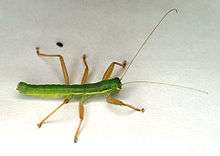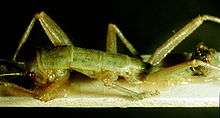Mantophasmatidae
Mantophasmatidae is a family of carnivorous wingless insects within the order Notoptera, which was discovered in Africa in 2001.[1][2] Originally, the group was regarded as an order in its own right, and named Mantophasmatodea, but, using recent evidence indicating a sister group relationship with Grylloblattidae (formerly classified in the order Grylloblattodea),[3][4] Arillo and Engel have combined the two groups into a single order, Notoptera.[5]
| Mantophasmatidae | |
|---|---|
 | |
| Mantophasma zephyra Zompro et al., 2002 | |
| Scientific classification | |
| Kingdom: | Animalia |
| Phylum: | Arthropoda |
| Class: | Insecta |
| Order: | Notoptera |
| Suborder: | Mantophasmatodea |
| Family: | Mantophasmatidae |
| Subfamilies, tribes | |
Overview
The most common vernacular name for this order is gladiators, although they also are called rock crawlers, heelwalkers, mantophasmids, and colloquially, mantos.[6] Their modern centre of endemism is western South Africa and Namibia (Brandberg Massif),[7] although a relict population, and Eocene fossils suggest a wider ancient distribution.
Mantophasmatodea are wingless even as adults, making them relatively difficult to identify. They resemble a cross between praying mantids and phasmids, and molecular evidence indicates that they are most closely related to the equally enigmatic group Grylloblattodea.[3][4] Initially, the gladiators were described from old museum specimens that originally were found in Namibia (Mantophasma zephyrum) and Tanzania (M. subsolanum), and from a 45-million-year-old specimen of Baltic amber (Raptophasma kerneggeri).
Live specimens were found in Namibia by an international expedition in early 2002; Tyrannophasma gladiator was found on the Brandberg Massif, and Mantophasma zephyrum was found on the Erongoberg Massif.[8]
Since then, a number of new genera and species have been discovered, the most recent being two new genera, Kuboesphasma and Minutophasma, each with a single species, described from Richtersveld in South Africa in 2018.[9]
Biology
Mantophasmatids are wingless carnivores. During courtship, they communicate using vibrations transmitted through the ground or substrate.[10]
Classification
The most recent classification[9] recognizes numerous genera, including fossils:

- Basal and incertae sedis
- Genus †Raptophasma Zompro, 2001
- Genus †Adicophasma Engel & Grimaldi, 2004
- Genus †Juramantophasma Huang et al, 2008.[11] (Daohugou Bed, Mid to Late Jurassic)
- Genus †Ensiferophasma Zompro, 2005 (may not belong to Mantophasmatodea)
- Subfamily Tanzaniophasmatinae
- Genus Tanzaniophasma Klass, Picker, Damgaard, van Noort, Tojo, 2003
- Species Tanzaniophasma subsolana (Zompro, Klass, Kristensen, & Adis 2002)
- Genus Tanzaniophasma Klass, Picker, Damgaard, van Noort, Tojo, 2003
- Subfamily Mantophasmatinae
- Tribe Tyrannophasmatini
- Genus Praedatophasma Zompro & Adis, 2002
- Species Praedatophasma maraisi Zompro & Adis, 2002
- Genus Tyrannophasma Zompro, 2003
- Species Tyrannophasma gladiator Zompro, 2003
- Genus Praedatophasma Zompro & Adis, 2002
- Tribe Mantophasmatini Zompro, Klass, Kristensen, Adis, 2002 (paraphyletic?)
- Genus Mantophasma Zompro, Klass, Kristensen, Adis, 2002
- Species Mantophasma gamsbergense Zompro & Adis, 2006
- Species Mantophasma kudubergense Zompro & Adis, 2006
- Species Mantophasma omatakoense Zompro & Adis, 2006
- Species Mantophasma zephyra Zompro, Klass, Kristensen, & Adis 2002
- Genus Pachyphasma Wipfler, Pohl, & Predel, 2012
- Species Pachyphasma brandbergense Wipfler, Pohl, & Predel, 2012
- Genus Sclerophasma Klass, Picker, Damgaard, van Noort, Tojo, 2003
- Species Sclerophasma paresisense Klass, Picker, Damgaard, van Noort, & Tojo 2003
- Genus Mantophasma Zompro, Klass, Kristensen, Adis, 2002
- Tribe Austrophasmatini Klass, Picker, Damgaard, van Noort, Tojo, 2003
- Genus Austrophasma Klass, Picker, Damgaard, van Noort, Tojo, 2003
- Species Austrophasma caledonense Klass, Picker, Damgaard, van Noort & Tojo, 2003
- Species Austrophasma gansbaaiense Klass, Picker, Damgaard, van Noort & Tojo, 2003
- Species Austrophasma rawsonvillense Klass, Picker, Damgaard, van Noort & Tojo, 2003
- Genus Hemilobophasma Klass, Picker, Damgaard, van Noort, Tojo, 2003
- Species Hemilobophasma montaguense Klass, Picker, Damgaard, van Noort & Tojo, 2003
- Genus Karoophasma Klass, Picker, Damgaard, van Noort, Tojo, 2003
- Species Karoophasma biedouwense Klass, Picker, Damgaard, van Noort & Tojo, 2003
- Species Karoophasma botterkloofense Klass, Picker, Damgaard, van Noort & Tojo, 2003
- Genus Kuboesphasma Wipfler, Theska & Predel, 2018
- Species Kuboesphasma compactum Wipfler, Theska & Predel, 2018
- Genus Lobatophasma Klass, Picker, Damgaard, van Noort, Tojo, 2003 (formerly Lobophasma)
- Species Lobatophasma redelinghuysense Klass, Picker, Damgaard, van Noort & Tojo, 2003
- Genus Minutophasma Wipfler, Theska & Predel, 2018
- Species Minutophasma richtersveldense Wipfler, Theska & Predel, 2018
- Genus Namaquaphasma Klass, Picker, Damgaard, van Noort, Tojo, 2003
- Species Namaquaphasma ookiepense Klass, Picker, Damgaard, van Noort, Tojo, 2003
- Genus Striatophasma Wipfler, Pohl & Predel, 2012
- Species Striatophasma naukluftense Wipfler, Pohl & Predel, 2012
- Genus Viridiphasma Eberhard, Picker, Klass, 2011[12]
- Species Viridiphasma clanwilliamense Picker, Klass, 2011
- Genus Austrophasma Klass, Picker, Damgaard, van Noort, Tojo, 2003
- Tribe Tyrannophasmatini
Some taxonomists assign full family status to the subfamilies and tribes, and sub-ordinal status to the family. In total there are 21 extant species described.[9]
See also
References
- K.-D. Klass, O. Zompro, N.P. Kristensen, J. Adis. Mantophasmatodea: a new insect order with extant members in the afrotropics Science, 296 (2002), pp. 1456–1459
- Adis, J., O. Zompro, E. Moombolah-Goagoses, and E. Marais. 2002. Gladiators: A new order of insect. Scientific American 287:60-65.
- Terry, M.D., and M.F. Whiting. 2005. Mantophasmatodea and phylogeny of the lower neopterous insects. Cladistics 21(3): 240–257.
- S. L. Cameron, S. C. Barker & M. F. Whiting (2006). "Mitochondrial genomics and the new insect order Mantophasmatodea". Molecular Phylogenetics and Evolution. 38 (1): 274–279. doi:10.1016/j.ympev.2005.09.020. PMID 16321547.
- Arillo, A. & M. Engel (2006) Rock Crawlers in Baltic Amber (Notoptera: Mantophasmatodea). American Museum Novitates 3539:1-10
- "Biodiversity Explorer: Mantophasmatodea". Iziko. Retrieved 30 June 2018.
- Zompro, O.; Adis, J.; Weitschat, W. (2002). "A review of the order Mantophasmatodea (Insecta)". Zoologischer Anzeiger. 241: 269–279.
- Zompro, O.; Adis, J.; Bragg, P.E.; Naskrecki, P.; Meakin, K.; Wittneben, M.; Saxe, V. (2003). "A new genus and species of Mantophasmatidae (Insecta: Mantophasmatodea) from the Brandberg Massif, Namibia, with notes on behaviour". Cimbebasia. 19: 13–24.
- Wipfler, B; Theska, T; Predel, R (2018). "Mantophasmatodea from the Richtersveld in South Africa with description of two new genera and species". ZooKeys. 746: 137–160. doi:10.3897/zookeys.746.14885. PMC 5904538.
- Randall, J. A. (2014). "Vibrational Communication: Spiders to Kangaroo Rats". Biocommunication of Animals: 103–133.
- Huang, Di-ying; Nel, André; Zompro, Oliver; Waller, Alain (2008-06-11). "Mantophasmatodea now in the Jurassic". Naturwissenschaften. 95 (10): 947–952. doi:10.1007/s00114-008-0412-x. ISSN 0028-1042.
- Eberhard, MJB, MD Picker and KD Klass. (2011). Sympatry in Mantophasmatodea, with the description of a new species and phylogenetic considerations. Organisms Diversity & Evolution 11(1): 43-59.
External links
| Wikimedia Commons has media related to Mantophasmatidae. |
| Wikispecies has information related to Mantophasmatidae |